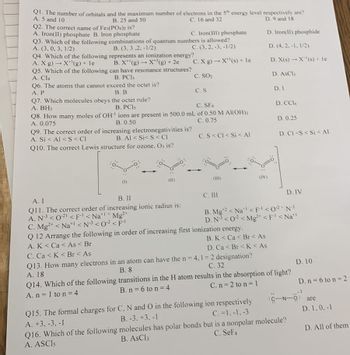
Chemistry
10th Edition
ISBN: 9781305957404
Author: Steven S. Zumdahl, Susan A. Zumdahl, Donald J. DeCoste
Publisher: Cengage Learning
expand_more
expand_more
format_list_bulleted
Concept explainers
Question
Q 9 please

Transcribed Image Text:Q1. The number of orbitals and the maximum number of electrons in the 5th energy level respectively are?
A. 5 and 10
B. 25 and 50
C. 16 and 32
D. 9 and 18
D. Iron(11) phosphide
D. (4.2.-1.1/2)
D. X(s)-X¹¹(s) le
D. AsCh
Q2. The correct name of Fes(PO4)2 is?
A. Iron(II) phosphate B. Iron phosphate
C. Iron(111) phosphate
Q3. Which of the following combinations of quantum numbers is allowed?
A. (3.0, 3, 1/2)
C. (3.2, -3, -1/2)
C. X g)
Q4. Which of the following
A. X g) X(g) + le
Q5. Which of the following
A. Cla
C. SO₂
B. (3.3.2.-1/2)
represents an ionization energy?
B. X'(g) X³(g) + 2e
1
can have resonance structures?
B. PCIs
Q6. The atoms that cannot exceed the octet is?
A. P
B. B
Q7. Which molecules obeys the octet rule?
A. BH3
B. PCIs
C. S
Q8. How many moles of OH¹ ions are present in 500.0 ml.
A. 0.075
B. 0.50
Q9. The correct order of increasing electronegativities is?
A. Si< Al <S<CI
B. Al < Si<S<CI
Q10. The correct Lewis structure for ozone. O, is?
A. I
B. 11
Q11. The correct order of increasing ionic radius is:
A. N³ <021 < F< Na¹¹ Mg²+
<
C. Mg2+ < Na <N³ <0² <F-¹
X(s) + le
C. SF4
of 0.50 M Al(OH)3
C.0.75
C.S< Cl< Si< Al
D. I
Q 12 Arrange the following in order of increasing first ionization energy.
A. K< Ca< As < Br
B. K<Ca< Br< As
C. Ca<K< Br< As
D. Ca< Br< K< As
Q13. How many electrons in an atom can have the n = 4,1 = 2 designation?
C. 32
B. 8
A. 18
D. CCla
D. 0.25
D. CI <S<Si < Al
C. III
B. Mg2 <Na <F¹ <0²²N³
D. N³ <02 <Mg²+ <F¹ <Na*
D. IV
Q14. Which of the following transitions in the H atom results in the absorption of light?
A. n = 1 to n = 4
B. n = 6 to n = 4
C. n=2 to n = 1
Q15. The formal charges for
A. +3. -3, -1
C, N and O in the following ion respectively
C. =1.-1.-3
B.-3. +3, -1
Q16. Which of the following molecules has polar bonds but is a nonpolar molecule?
B. AsCl3
A. ASCIS
C. SeF4
D. 10
D. n = 6 to n = 2
C-N-O are
D. 1.0.-1
D. All of them
Expert Solution
arrow_forward
Step 1
Answer:
Electronegativity value increases from left to right in a period in the periodic table.
Step by stepSolved in 2 steps

Knowledge Booster
Learn more about
Need a deep-dive on the concept behind this application? Look no further. Learn more about this topic, chemistry and related others by exploring similar questions and additional content below.Similar questions
- Just #2 pleasearrow_forward400 380 360 340 320 300 280 260 240 220 200 180 160 - 140 120 - 100 80 60 40 20 -20 - -40 -60 - -80 40 80 120 Heat (J) Temperature (°C)arrow_forwardAn organic chemist measures the temperature T of a solution in a reaction flask. Here is the result. T=56. °C Convert T to SI units. Round your answer to 0 decimal places. OK |x10arrow_forward
- 0 Y 0 0arrow_forwardBalance each chemical equation. Part C Part D Cl (g) + NaOH(aq) —i NaC103(aq) + NaCl(aq) + H 0(1) Express your answer as achemical equation. Identify all of the phases in your answer. A chemicalreaction does not occur for this question. Request Answer ProvideFeedbackarrow_forwardAktiv Chemistry < X + app.101edu.co Type here to search Your Aktiv Learning trial expires on 08/29/22 at 07:08 PM A chemist has a block of iron metal (density is 7.87 g/mL). The block weighs 2.10 g. What is the volume of the iron block in mL? O S Question 37 of 73arrow_forward
- 11. Billy is running away from a Wells Fargo bank at a speed of 13 kilometers per hour (units are km/h). If the distance between the bank and the border to Mexico is 1.9 km, will he be able to get there before the cops arrive in 9 minutes? How long will it take for him to reach the border? (Hint: speed = distance / time, 1 hour = 60 minutes)arrow_forward2-arrow_forwardThe world population is estimated to be 7.4 x 109. Nauru is the smallest island nation and comprises 1.5 x 10-4% of the world population. If the percentage of left-handed people is approximately 12%, estimate the number of left-handers on the island of Nauru.arrow_forward
arrow_back_ios
arrow_forward_ios
Recommended textbooks for you
 ChemistryChemistryISBN:9781305957404Author:Steven S. Zumdahl, Susan A. Zumdahl, Donald J. DeCostePublisher:Cengage Learning
ChemistryChemistryISBN:9781305957404Author:Steven S. Zumdahl, Susan A. Zumdahl, Donald J. DeCostePublisher:Cengage Learning ChemistryChemistryISBN:9781259911156Author:Raymond Chang Dr., Jason Overby ProfessorPublisher:McGraw-Hill Education
ChemistryChemistryISBN:9781259911156Author:Raymond Chang Dr., Jason Overby ProfessorPublisher:McGraw-Hill Education Principles of Instrumental AnalysisChemistryISBN:9781305577213Author:Douglas A. Skoog, F. James Holler, Stanley R. CrouchPublisher:Cengage Learning
Principles of Instrumental AnalysisChemistryISBN:9781305577213Author:Douglas A. Skoog, F. James Holler, Stanley R. CrouchPublisher:Cengage Learning Organic ChemistryChemistryISBN:9780078021558Author:Janice Gorzynski Smith Dr.Publisher:McGraw-Hill Education
Organic ChemistryChemistryISBN:9780078021558Author:Janice Gorzynski Smith Dr.Publisher:McGraw-Hill Education Chemistry: Principles and ReactionsChemistryISBN:9781305079373Author:William L. Masterton, Cecile N. HurleyPublisher:Cengage Learning
Chemistry: Principles and ReactionsChemistryISBN:9781305079373Author:William L. Masterton, Cecile N. HurleyPublisher:Cengage Learning Elementary Principles of Chemical Processes, Bind...ChemistryISBN:9781118431221Author:Richard M. Felder, Ronald W. Rousseau, Lisa G. BullardPublisher:WILEY
Elementary Principles of Chemical Processes, Bind...ChemistryISBN:9781118431221Author:Richard M. Felder, Ronald W. Rousseau, Lisa G. BullardPublisher:WILEY

Chemistry
Chemistry
ISBN:9781305957404
Author:Steven S. Zumdahl, Susan A. Zumdahl, Donald J. DeCoste
Publisher:Cengage Learning

Chemistry
Chemistry
ISBN:9781259911156
Author:Raymond Chang Dr., Jason Overby Professor
Publisher:McGraw-Hill Education

Principles of Instrumental Analysis
Chemistry
ISBN:9781305577213
Author:Douglas A. Skoog, F. James Holler, Stanley R. Crouch
Publisher:Cengage Learning

Organic Chemistry
Chemistry
ISBN:9780078021558
Author:Janice Gorzynski Smith Dr.
Publisher:McGraw-Hill Education

Chemistry: Principles and Reactions
Chemistry
ISBN:9781305079373
Author:William L. Masterton, Cecile N. Hurley
Publisher:Cengage Learning

Elementary Principles of Chemical Processes, Bind...
Chemistry
ISBN:9781118431221
Author:Richard M. Felder, Ronald W. Rousseau, Lisa G. Bullard
Publisher:WILEY